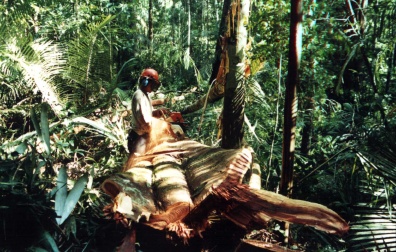 "Ecological correct" felling in the Precious Woods mangement area
"Ecological correct" felling in the Precious Woods mangement area
What is the FSC?
With respect to the timber business, the attempts at conciliation led in 1993 to the founding of the FSC, bringing together environmental, social and economic interest groups. The FSC is responsible for defining a set of global principles and criteria for 'well managed' forests. Based on these guidelines private certifying bodies carry out the FSCcertification of logging operations.
To guarantee success for the new initiative WWF established Buyer's Groups for FSC certified timber. Today some of the largest timber retailers are members of these Buyer's Groups, most of them having been former targets of boycott campaigns. Their demand is an important factor in the recent expansion FSC certified forests. Having surpassed the ambitious target of 25 million hectares of certified forests worldwide, WWF in alliance with the World Bank, is now aiming for 200 million hectares of certified forests by 2005.
This success story is not without its problems especially with respect to logging in tropical primary forests. One of the most notorious cases was a certified logging concession in Gabon, where illegal bush meat trade of chimpanzees and gorillas was common practice. It was not the FSC but a small independently funded German environmental organisation2, which researched the case and ran a twoyear campaign to have the certification revoked.
In spite of this and other incidents, certification of primary forests continues to be enthusiastically promoted by environmental heavyweights and now occupies the heart of the Greenpeace Amazon campaign. While denouncing illegal logging in the region, Greenpeace has sought acceptable alternatives for the logging industry. They found what they thought was needed in Precious Woods Amazon, a company which was FSCcertified in 1997.
This Swiss owned company was founded in 1994 with the intention to prove that sustainable logging in tropical regions is economically viable. In mainstream forestry circles the project is recognised as one of the best examples of planned logging in primary tropical forests. This example has now been followed by Gethal, the largest foreign logging company in the Amazon state, certified last year. Greenpeace is now negotiating the certification of WTK3, a Malaysian company with an appalling history of environmental and social abuses. This 'conversion' of predatory logging companies is being celebrated with evangelical fervour by supporters of FSC. However if certified logging of the disappearing rainforests is the answer perhaps we have forgotten what the question was.
What sort of development for the region is certification really promoting? Who are the beneficiaries of this development model? What impact does certified timber extraction have on native forests? Does buying certified tropical timber products really contribute to saving the world's rainforests? Using as a reference Precious Woods Amazon, these questions are addressed through an analysis of the myths commonly used to defend certified logging of primary forests.

Silvicultural techniques: killing trees by cutting a ring of bark around the trunk
Myth 1: Certified logging of primary tropical forests has minimal impact on the forest ecosystem.
The logging system employed by Precious Woods Amazon involves a 100% inventory of trees and carefully planned infrastructure based on satellite images. Within the management area of 61.718 hectares, five percent (2700 hectares) is clearcut for roads, skid trails and stocking areas. After felling the trees this results in approximately 20% of the forest canopy being opened4.
The managed forest is crisscrossed with 400 km of permanent and 5000 km of secondary access roads5maintained in better conditions than most public roads. These allow the ingress of local people for wildlife poaching, proving difficult for the company to control. If Precious Woods Amazon moves on from this area the road access will remain, inviting farmers, settlers and other logging companies to wreak a second wave of damage.
Silviculture techniques are adopted to encourage the growth of commercially lucrative species. First larger diameter, more mature, target species are felled and removed. Later, nearby trees with no market value are anneled (a ring of bark is cut from around the trunk) and left to die standing. In turn this causes drying of the forest floor, which together with the presence of dead anneled trees increases the danger of forest fires. These Silviculture techniques profoundly alter the species composition and the age of the forest. With time, an ancient ecosystem is transformed into an artificial land use system.
The environmental sector of FSC uses its pressure to progressively tighten the criteria for certification, reducing the volume of wood extracted. However for certified companies to be economically viable production quotas need to be maintained. This in turn necessitates opening up new areas of undisturbed primary rainforest. In this way certified logging is creating a new forest frontier; the access infrastructure required for certified management opening up ever remoter regions of tropical forest.
 Secondary road within the Precious Woods mangement area
Secondary road within the Precious Woods mangement area
Myth 2: By increasing the market value of tropical timber, FSC certification puts economic value on forests. This creates a disincentive for more damaging land use, such as clear cutting for agriculture.
This myth might be supported by new data from IMAZON demonstrating that planned timber extraction yields 33% interest return on investment per unit area in comparison with cattle ranching with only 14%6. However the real dynamics of these land use options determine that forest clearance for agriculture and timber extraction rarely compete as economic alternatives.
Brazilian farmers and landowners simply do not feel the need to include percentage interest return or land productivity into their calculations. The expansion of the agricultural frontier is promoted through access to land made cheap through subsidies and special tax regulations7. This encourages shortterm profits from transforming forest into pasture rather than investing in new methods of forest use. The political clout of the farming industry ensures that the incentives that consider natural forest as nonproductive remain in place. This predisposition is further exaggerated by the extreme wealth concentration in Brazil. For those few who have capital, land scarcity and thus productivity is not an issue. Under these circumstances the FSC provides no meaningful incentive to turn cattle ranchers and soya farmers into foresters.
However, certification certainly is providing a survival option for a growing number of the large logging companies. Many of these companies were facing bankruptcy due to pressure from the state environmental agency and international boycotts. The new green markets overseas are perceived as a lifeline8 as are the institutional support and the international funds available after taking the FSC vows.
The timber industry seeks high value tree species in undisturbed forest. Thus logging companies tend to operate in areas geographically distant from the agricultural frontier. By establishing the transport infrastructure in remote forested regions, these model companies may rather facilitate the entrance of clear cutting for agriculture and colonization.
Certification does provide an incentive for better planned logging but is merely a voluntary marketing tool and not a long term binding obligation. As such, it will only work while guaranteeing maximum profit for the logging company. If certified timber loses its commercial advantage the company will drop the capital intensive certified management and revert to more predatory practices
9.
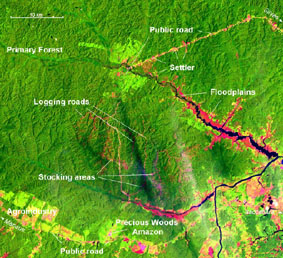 Satellite image of the Precious Woods Management area demonstrating the network of roads established within the forest
Satellite image of the Precious Woods Management area demonstrating the network of roads established within the forest
Source: K. Laschefski, Original: INPE: Landsat TM 5 WRS: 230/062 + 00 99-11-27 UTM)
click here for larger map
Myth 3: With so many trees and a growing global demand for wood, logging is the inevitable economic vocation for the Amazon.
Logging has been defined as unavoidable by the political, economic and academic beneficiaries of the timber industry. Forestry is considered a science that justifies our species' interference with forest ecosystems. Ever more foresters are employed by research institutes, environmental NGOs and international funding agencies. Their expertise is sought on literally all issues related to forests. Yet foresters are trained almost exclusively how to cut down trees. Faced with a forest, they are conditioned see wood and not trees; to see marketable cubic meters of timber and not ecosystems.
One example of the monopoly the foresters vision is ´Promanejo', a joint project of international development agencies and the Brazilian government. Promanejo is part of the Pilot Project for the Preservation of Tropical Rainforests of the G7 countries (PPG7), established to develop sustainable uses of tropical forest resources. However Promanejo interprets forest resources exclusively as timber. Both Gethal and Precious Woods have benefited from these funds; Gethal recently receiving $382,000 for personnel training and Precious Woods Amazon $238,000 for an education centre to promote their forest management system.
In contrast, land use systems of indigenous peoples and riverside dwellers continue to be marginalised. Traditional people value most highly, intact forest which needs to be preserved in its entirety to continue to yield the enormous diversity of products. This land use represents an efficiency and sustainability that industrial forestry will never be able to attain. Sustainable development does not require transformation of local people into foresters. It does require that those intent on creating meaningful sustainable economies for the region, learn from local people's knowledge of forest ecosystems and understand their needs. The range of non timber economic alternatives includes brazil nuts, tree oils and essences, guarana, medicinal plants, babassu, honey, art work and an endless list of exotic fruits with well established markets. The diversity of these options makes them less dependent on economic monopolies and less vulnerable to the vicissitudes of global markets. These local economies are collectively of a scale easily competing with the logging industry in terms of economic returns. However these real alternative economies are left unexplored as the trees come down.
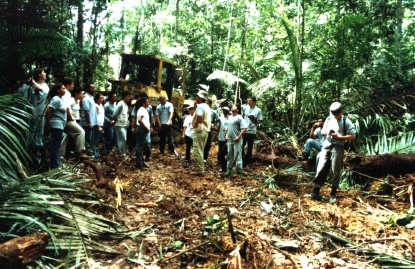 Local people treceiving training in forestry
Local people treceiving training in forestry
Myth 4: Planned logging by certified companies stimulates the local economy, offers job opportunities for local people and provides an alternative to the traditional land use systems which worsen deforestation
The logging industry exacerbates an ununsustainable boom bust economy. Periods of expansion intensifies rural to urban migration as local people are drawn to cities by prospects of jobs in sawmills. Production and economic crisis of the industry are common, caused by fluctuating demand of unstable markets, fining and control by government environmental agencies, international timber boycotts and supply problems due to species scarcity and transport difficulties. After stimulating expansion of the urban population, these downturns in the logging economy intensify urban unemployment. In addition, with the infrastructure, academic, political and human resources focused on logging, there has been little opportunity for the development of more diversified, stable and sustainable economies.
Precious Woods Amazon is established in Itacoatiara, the principal logging centre of the Amazon state, 200 km from Manaus. Arriving in the 1990s at a time when the timber industry was in an economic trough, it was easy to find unemployed workers already living in the town. The creation of 300 jobs in Precious Woods Amazon was welcome but has hardly dented the local employment crisis. Instead its presence has helped maintain local economic dependence on foreign capital and rapidly changing external markets. This precarious economy is reflected in the unstable internal situation of the company, whose management area in Itacoatiara is proving unable to guarantee the profit return required to demonstrate economic viability. Seeking a larger area of undisturbed forest with a higher concentration of valuable tree species Precious Woods recently acquired an area of 179.000 hectares of rainforest in the neighbouring state of Pará. Transferring its operations to Pará, the company will leave the economy of Itacoatiara in as a precarious state as it was found.
Precious Woods Amazon has clearly a better record with employees wages, working conditions, job security and union rights creating pressure on other companies to follow suit 10. However, a worker's monthly salary at Precious Woods Amazon is only 20 Real higher than the minimum wage of 151 Real ($79.00), inadequate to support the average local family. Considering the purchasing power the minimum wage when it was introduced 60 years ago, today it should be 489 Reals11.
The environmental consequences of Precious Woods Amazon might be evaluated by comparing its impact as a local employee with land use of other local people (see table12).
Employement in relation to area (Hectares/employed Person) from Extensive and Intensive Economic Activities (case study of Paragominas, Pará)
| |
LOGGING* |
CATTLE RANCHING |
FAMILY AGRICULTURE |
| |
Extensive Logging
Cycle of
90 years |
Intensive Logging
Cycle of
30 years |
Extensive
Unreformed
pastures |
Intensive
reformed
pastures |
Extensive
Slash and burn |
Intensive
Perennial cultures |
| ha/person |
540 |
154 |
29 |
29 |
16 |
1.4 |
*Logging was analyzed without considering land investment and/or timber processing at sawmill.
Source: Almeida O. e C. Uhl (1995), "Developing a quantitative framework for sustainable resource-use planning in the Brazilian Amazon", World Development 23 (10): 1745-64.
Rural families use an average of five hectares to plant basic food crops in rotation13. Precious Woods Amazon transforms 2.700 hectares inside the managed areas into transport infrastructure. This is equivalent to an area required for the subsistence of 540 traditional families.
Looked at another way Precious Woods Amazon with its intensive logging cycle of 30 years employs currently 300 people on their 61.000 ha managed area. Thus, to solve the problem of an estimated 10.000 unemployed workers in Itacoatiara, 2.030,000 hectares of primary forest would be needed to be transformed for logging. Imagine the expanse of forest required to solve the unemployment problem in Manaus.
Unable to survive on the salary from the saw mill many workers also have small land plots augmenting further the land effectively consumed by Precious Woods employees. In addition every day 300 workers eat company canteen food provided by farms and cattle ranches along the road between Itacoatiara and Manaus. The impact of these urban consumption patterns can be seen in the widening strip of deforestation clearly demonstrated on the satellite image.
The recently certified logging operation of Gethal provides another clear example of how certified companies compete with lower impact and more socially just, local land use systems. Within their 40.000 ha management area live 1.200 local people in seven riverside communities. They have no land rights but depend on the land. With approval of the certified management plan, these communities are legally prohibited from practising their subsistence activities14, specifically collecting Brasil nuts, without Gethal's permission. The communities with the support of the local church, have denounced this injustice15. In addition they complain that the road building for the logging, is making access to the Brasil nut trees difficult and the hunting scarce. As a result of this certified management plan, 1.200 local people who lived from harvesting of the forest are facing an uncertain future. It is likely that, migrating to nearby towns, they will become part of the growing population of the urban unemployed.
 Forestry: Vocation for local people in the Amazon?
Forestry: Vocation for local people in the Amazon?
Myth 5: Certified logging companies are committed to complete transparency. In addition to the usual governmental control, their activities are monitored by certifying bodies whose role is to ensure that the standards of certifications are met and maintained.
Given the chaos and illegality of the Brazilian logging industry, certification seems to offer the incentives and penalties required to lever companies into better behaviour. Certainly, companies will be less willing to lose their ecological niche markets by engaging in illegal activities. However, when it is a question of profit, even these constraints have not stopped model companies engaging in dubious practices.
The case of Acuariquara shipments from Precious Woods Amazon is one example. Acuariquara is a durable species of tropical timber with insignificant local markets. International demand for the species was created when the German municipality of Rostock decided to use certified acuariquara for coastline construction work. The contract was celebrated as a transatlantic partnership helping to preserve the rainforest. However Precious Woods Amazon had insufficient acuariquara to respond to the demand. To complete the shipments, wood was bought through an Austrian company, MW Florestal from local people, in unmanaged areas. This led to confusion as to which batches of acuariquara arriving in Rostock were certified and which were not16.
At the same time, there arose a series of illegal logging incidents involving acuariquara in the neighbourhood of Precious Woods Amazon. In one case, authorisation to clearcut a small plot for agriculture was used to rip out hundreds of acuariquara trees using the company's tractors and personnel17.. In another incident at an FSC meeting, a local mayor denounced the company for illegally removing acuariquara within his municipality18. Beyond the possible explicit involvement in illegal logging, opening the market for acuariquara helped stimulate a local boom in illegal logging19. Clearly, it is difficult to neatly contain the economic incentive for logging to a management plan area.
Following these incidents, ranks were quickly closed around Precious Woods Amazon the opposite of what one might have hoped for with the certification preamble about transparency. As with the case in Gabon, it was left to small, under funded environmental groups and concerned individuals to investigate.
This reflects the murky constellation of interests within the FSC, where entities responsible for monitoring operations are those with vested interests in the model's success. The certifier is on the logging companies payroll. For the dominant environmental groups, such as Greenpeace, WWF and Friends of the Earth, certification is their negotiating card with industry and the heart of the forest campaigns. With the growing alliance between the industry and environmental organisations and their mutual investment in the success of this model, voices of dissent are not welcome and thus rarely heard.
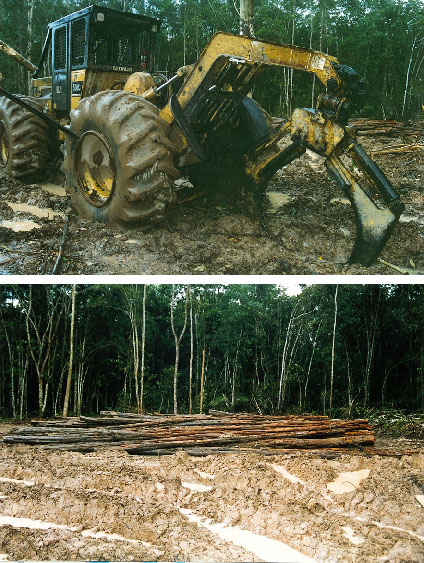 Illegal Logging of Acuariquara
Illegal Logging of Acuariquara
Myth 6: Selective logging increases the carbon fixing capacity of primary forests and should be promoted through certification to reduce global warming.
Selective logging keeps the forest in a permanent state of recovery, taking wood out and stimulating the growth of new trees. On the basis of this dynamic, the defenders of logging of primary forests assert that selective logging stimulates carbon fixation and an overall reduction in greenhouse gases. According to this argument, untouched primary forests have less carbon fixing potential and less value in climate control than managed forests20. However these assertions depend on assumptions about the time carbon in the extracted timber will remain fixed and whether managing forests will remain intact forever.
A brief look at the processing and use of tropical timber demonstrates that the end products rarely fix carbon permanently. Approximately 70% of logs arriving in Amazonian sawmills end up as waste, a mere 30% being processed into sawn planks. This wastage is even greater in the production of laminates and plywood. The 70% of waste wood is usually either burned or as in the case of Precious Woods Amazon, used to produce charcoal immediately sending carbon which was fixed in forests into the atmosphere. There is further wastage and CO2 production as planks, laminates and plywood are transformed into doors, walls, floors and furniture. There is no available data on the average life span of these end products, but it is clearly unlikely that they will survive the centuries or even decades required to be considered permanent fixation of carbon. Apart from the odd art item or museum piece most of this wood will end up being transformed in urban incinerators into CO2.
Indirect sources of CO2 production resulting from planned selective logging must also be considered. These include production from the infrastructure, equipment and transport required for industrial logging operations.
All this CO2 production must at least be compensated for by the regrowth of managed forests which must remain intact forever. As described in Myth 1, selective cutting increases the susceptibility of forests to uncontrolled fires one of the greatest sources of CO2 production in Brazil over the last five years. In addition the infrastructure offered in managed forests increases the risks of colonisation and clearcutting for pasture and agriculture, representing permanent removal of the forest bound carbon, all adding up to the carbon debts and not credits.
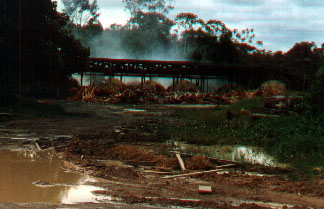 Charcoal production at Precious Woods Amazon
Charcoal production at Precious Woods Amazon
Myth 7: Many consumers in Europe and in the United States are willing to pay more for products with "green labels". Operating within the economic reality of competitive global trade, certification is becoming an essential tool for environmental preservation.
Important traders participating in the FSC buyer's groups have created the impression of huge, ecologically sensitive markets. This mirage has been convenient for government and industry keen to find ecological solutions which leave unquestioned the economic foundations of the present environmental crisis. The cause of our social and ecological malaise has become the cure the world can now be saved by shopping.
The issue of certification was discussed at an expert working group for the UN Commission of sustainable development in 199621. As bans and boycotts are considered incompatible with the rules of the World Trade Organisation, certification was accepted under three conditions: First, there should be a open market for all certification schemes, the market defining the best initiative. Second, there should be no political action to diminish the trade of uncertified products. Third, the origin of the timber should not be included on the product label to avoid discriminatory actions against specific regions22. These conditions ensure markets remain open for products from predatory and illegal sources. The responsibility for combating environmental and social crime is transferred from governments into the hands of consumers faced with hundreds of ecolabels, the vast majority of which are a result of opportunistic product marketing. Environmental organisations are now engaged to defend the FSC is the only "trustworthy" ecolabel. This has been at the cost of political action directed at the underlying causes of forest destruction.
Research indicates that markets for "green products" are very limited. Half of German consumers pay attention to ecolabelled products, but only a third would pay 5% more for them. This is inadequate to effect changes required for sustainable forest use23. Consumer behaviour is notoriously fickle and these statistics do not reflect real life situations where even ecologically aware consumers with limited finances, may opt for a cheaper uncertified product.
Certified tropical timber sold to an ecologically conscious elite of the first world has little in fluence on the global dynamics of the timber business. Within Brasil, 85% of timber from the Amazon is consumed in internal markets24. It is these markets that help sustain illegal logging in the region, estimated at 80%. Lowincome Brazilians do not have the luxury of consumer choice offered by certification. In a study conducted about their willingness to pay higher prices for certified products, the response was that the responsibility for ecologically and socially sound products should be with the government and not with the consumers25.
What can be done ?
Many people supported FSC in the hope that through valuing tropical timber, tropical forests would be preserved. Many thought FSC would empower local people in small, community based initiatives, offering an alternative to more destructive land use. In reality FSC is supporting industrial scale logging of the worlds remaining primary forests. Presently, ninetysix percent of certified forests is accounted for by industrial or governmental forest owners, with 85% being in holdings of more than 100,000 hectares. Only 34% of the total number of certificates, covering 3% of the certified land area, is accounted for by communal groups and nonindustrial users26.
Certification probably has insignificant impact in halting predatory logging practices in tropical forests. Meanwhile, FSC is levering open tropical timber markets in Europe and USA closed during the 90s boycott campaign. It is offering a survival option for logging companies and attracting new international investments for logging of primary forests. All evidence indicates that certified logging has a profound impact on tropical ecosystems. Establishing transport infrastructure in remote regions, certified companies represent a new logging frontier. In addition, there is no evidence that raising the price paid for certified timber acts as a disincentive to clearcutting for agriculture or pasture. The local social benefits offered by certified companies are minimal. Under these circumstances buying certified tropical timber is no more than an additional pressure on primary forests.
The investment, support and marketing of certification is helping to create an economic, academic and environmental culture which supports the logging industry. Massive financial and human resources are being invested in certified logging; resources which should be spent on more meaningful forms of forest preservation.
There are undoubted improvements in planning and control of certified logging operations, but embedded in a logic of linear production, regarding the forest ecosystem as a oneoff extraction of wood. In essence by buying FSC timber, consumers are supporting the exploitation of raw material from a developing country by multinational companies.
Rather than buy into the myth, individuals and organisations wanting to meaningfully contribute to the preservation of the worlds remaining tropical forests, might better choose to adopt the following proposals
- End all schemes for certification of tropical timber from primary forests.
- Boycott all tropical timber in Europe and North America.
- Support fair trade initiatives of non timber forest products with direct links to local communities.
- When absolutely necessary buy timber produced locally from secondary forests
- Invest in improving control by governmental agencies of illegal logging and gradual tightening of state regulations for legal logging.
- Invest in community based, non timber forest products as economic alternatives.
- Invest in reforestation schemes of degraded areas.
Footnotes and References
1 see: ZHOURI, A. (1998): Trees and People. An Anthropology of British Campaigners for the Amazon Rainforest. Department of Sociology. University of Essex.
2 REGENWALD REPORT No 4/96: Neue Hoffnung für den Wald? FSC, Rettet den Regenwald, Hamburg.
LASCHEFSKI, K. (1997): Ökozertifikate für Tropenholz kritisch hinterfragt. In: Perubüro Heidelberg: Themenheft
Amazonien. El Dorado? Peru Nachrichten Nr. 42, 10/97, 13. p.9195.
3 Greenpeace circular, November 2000.
4 ITTO/OIMT/FUNPAR/IBAMA (1999): "Disseminação de treinamento nas Diretrizes e Criterios da ITTO/OIMT, Fase II, Estagio 2, Projeto PD 30/95 Relatorio de Assessoramento técnica à Empresas Mil Madeireira Ita. Ltda, Documento 6/B, Curitiba, September 1999.
5 Calculation based on data provided by Precious Wood Amazon.
6 VERISSIMO, A., /E. ARIMA & P. BARRETO (2000): A derrubada de mitos amazônicos. Folha de São Paulo, 28 de Maio de 2000, Folha Mais Raízes do Brasil, p. 27/28.
7 One example is the Imposto Territorial Rural (ITR), representing reduced taxation of landowners in the Amazon when they increase agricultural productivity. Until 1999 any kind of forest uses where excluded. See: GAZETA MERCANTIL (17.03.99): O novo ITR e as florestas nativas. p. 2.
8 GAZETA MERCANTIL (08.03.99): Madeireiras devem exportar mais 20%. p. B20. GAZETA MERCANTIL (19.03.99): Selo verde é passaporte mundial. p. 10.
A CRITICA (14.03.99): Selo verde chega à madeira tropical. p. E4.
9 GAZETA MERCANTIL (0507.03.99):
Subsidiára da Vale perde o selo verde. p. A13.
10 Based on Interviews with the local trade union (Sindicato dos Trabalhadores da Industria Madeireira, Itacoatiara) in July 2000.
11 SANTA CRUZ, A. (2000): Mínimo não cria rombo, diz Pochmann. In: Folha de São Paulo, 23 de fevereiro de 2000.
12 Interviews with B. Ribeiro dos Santos ASPAC (Associação de Silves pela Preservação Ambiental e Cultural) in Silves and IBAMA officials in Itacoatiara, July 2000.
13 ALMEIDA, O. & C. UHL (1995), "Developing a quantitative framework for sustainable resourceuse planning in the Brazilian Amazon", World Development 23 (10). p. 174564.
14 Governo do Estado do Amazonas Instituto de Proteção Ambiental do Amazonas (2000): "Projeto de Gestão Ambiental Integrada PGAI /AM. Relatório técnico das atividades realizadas no município de Manicoré / AM. Manaus.
15 Information from the Amazon office of the The Pastoral Land Commission (CPT).
16 OSTSEEZEITUNG (11.08.98): Amt kaufte Regenwald Holz zweiter Klasse. p.13.
17 Prefeitura Municipal de Presidente Figueirido (1998): Relatorio percial de constatação de dano ambiental. Extração de madeira no sitio "Boa Esperança", Comunidade Bom Futuro, margem direita do Rio Uatumã, jusante da Cachoeira da Morena/Presidente Figueiredo AM 25 June 1998.
18 see: A CRITICA (03.98): Mil Madeireira faz exploração ilegal. p. E2.
19 Illegal logging of aquariquara along the road from Itacoatiara to Silves (Estrada de Varzea), confirmed by officials of the IBAMA, Itacoatiara, in July 2000.
20 see for example HIGUCHI, N. et al (1997): Projeto Bionte Biomassa e nutrientes florestais. Relatório Final, Sumário Executivo, Manaus, p. 6. see for example HIGUCHI, N. et al (1997): Projeto Bionte Biomassa e nutrientes florestais. Relatório Final, Sumário Executivo, Manaus, p. 6.
21 International Experts'Working Group Meeting, Bonn, 1216 August 1996: "Trade, Labeling of Forest Products and Certification of Sustainable Forest Management"
22 see working papers for the the International Experts' Working Group Meeting, Bonn, 1216 August 1996: "Trade, Labeling of Forest Products and Certification of Sustainable Forest Management"
23 BROCKMANN, K. L., J. HEMMELSKAMP & O. HOHMEYER (1996): Certified Tropical Timber and Consumer Behavior The Impact of a Certification Scheme for Tropical Timber from Sustainable Forest Management on German Demand. Zentrum für Europäische Wirtschaftsforschung, Mannheim, p. 30.
24 see: SMERALDI, R. & A. VERISSÏMO (1999): Acertando o alvo Consumo de madeira no mercado interno Brasileiro e promoção da certificação florestal, São Paulo.
25 the results of the research will be presented in a PhD thesis which is to be worked out by Laschefski, K. at the end of the year 2001.
26 COUNSELL, S. (1999): Trickery or Truth an Examination of the Effectiveness of the Forest Stewardship Council. The Rainforest Foundation, London.
Download as pdf-File
Seeing the Wood from the Trees, 280 kB |
 |
Contact: Klemens Laschefski
email: klemens.laschefski@gmx.net
| 






